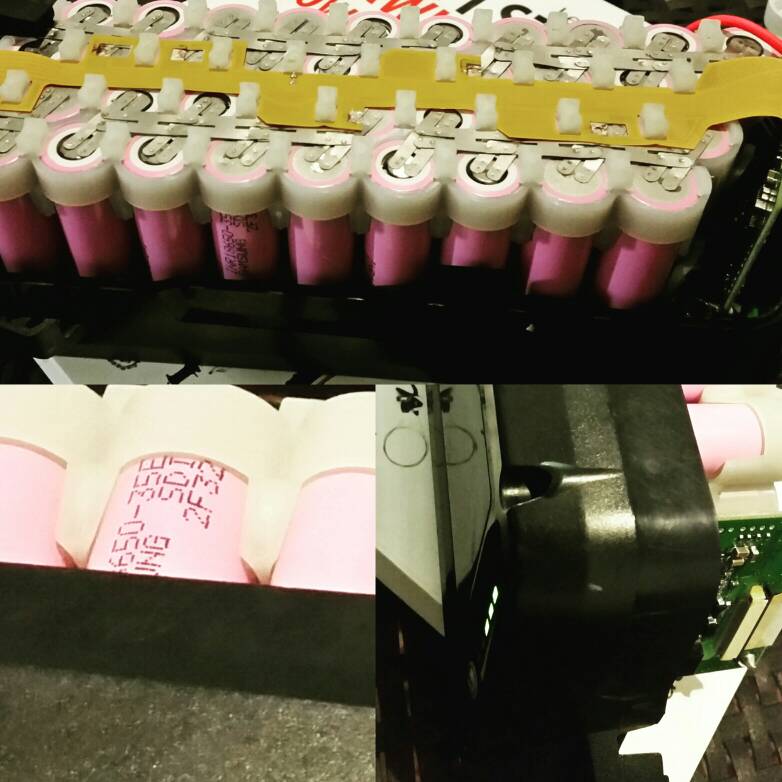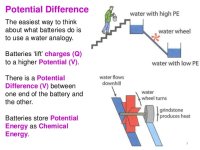You are using an out of date browser. It may not display this or other websites correctly.
You should upgrade or use an alternative browser.
You should upgrade or use an alternative browser.
CHEAP NEW ORIGINAL 18650 21700 BATTERY CELLS, POUCHES AND PACKS
- Thread starter tumich
- Start date
cwah
100 MW
Any cycling data?
I got 3350 MAH (capacity test only) with the Sanyo cells at 1 amp. Which is around what others got at 1 amp, and basically meets the cell capacity specification. Cells have July 2015 date I believe.
I had to actually make sure to cycle the battery at around 25C, because below this temp you will get noticeably lower capacity. My basement is around 14C in the winter so I had to improvise to cycle the cell at 25C.
I also had to make sure to get the cell to exactly 4.200 volts before discharge.
I had to actually make sure to cycle the battery at around 25C, because below this temp you will get noticeably lower capacity. My basement is around 14C in the winter so I had to improvise to cycle the cell at 25C.
I also had to make sure to get the cell to exactly 4.200 volts before discharge.
Do you have a source or name for those cell holders?vsop said:
They are perfect for putting the cells as close together as possible.
Cheers
markz
100 TW
tumich said:There are holders which are inside Bosch PowerPack's.
BINGO, I guessed right in my previous post! Someone asked, I threw out my guess, went unanswered, asked again and answered.
Thanks for the info.
That sucks they are Bosch only. I would have like to use some of them for my builds.
Oh well...a minute amount of weight savings without them at least.
Cheers
That sucks they are Bosch only. I would have like to use some of them for my builds.
Oh well...a minute amount of weight savings without them at least.
Cheers
ridethelightning
1 MW
- Joined
- Jul 21, 2013
- Messages
- 2,010
220 LG mg1 cells, arrived sept14, been running solid ever since, still going strong!
thanks again tumich!
thanks again tumich!
DasDouble
100 kW
pm send.
markz
100 TW
My birthday is coming, and I need something more then 60V and 8 to 9Ah of battery pack. Summer is coming, seems like a perfect time to splurge on some 3.5Ah GA's.
Whats the transit time on these batteries again, to North America? Lets say BC, AB or West coast of USA.
Whats the transit time on these batteries again, to North America? Lets say BC, AB or West coast of USA.
DasDouble
100 kW
A Guy told me that the cells wouldnt work correctly for high voltage like 74 Volts, 20Ah, 22s. What do you guys think? Want to buy the Sanyo ones because people here say they are as good as Panasonic. 
> the cells wouldnt work correctly for high voltage like 74 Volts
I am sorry you have to listen to a "Guy" that tells you that kind of non-sense
Better not to listen to him any more, because the statement in itself is ridiculous:
The individual cell in the chain knows nothing about the total Voltage of the pack.
Each of them just sees their own 3.7-4.2V
You can put as many as you like in a series - with any type of cells.
> Want to buy the Sanyo ones because people here say they are as good as Panasonic.
Read here: https://en.wikipedia.org/wiki/Sanyo
"On December 21, 2009, Panasonic completed a 400 billion yen ($4.5 billion) acquisition of a 50.2% stake in Sanyo, making Sanyo a subsidiary of Panasonic."
Also read Here: https://www.electricbike.com/18650-cells-for-e-bike/
and look for : '' What happened to Sanyo? "
Cheers, Ulli
I am sorry you have to listen to a "Guy" that tells you that kind of non-sense
Better not to listen to him any more, because the statement in itself is ridiculous:
The individual cell in the chain knows nothing about the total Voltage of the pack.
Each of them just sees their own 3.7-4.2V
You can put as many as you like in a series - with any type of cells.
> Want to buy the Sanyo ones because people here say they are as good as Panasonic.
Read here: https://en.wikipedia.org/wiki/Sanyo
"On December 21, 2009, Panasonic completed a 400 billion yen ($4.5 billion) acquisition of a 50.2% stake in Sanyo, making Sanyo a subsidiary of Panasonic."
Also read Here: https://www.electricbike.com/18650-cells-for-e-bike/
and look for : '' What happened to Sanyo? "
Cheers, Ulli
Hummina Shadeeba
1 MW
im not trying to promote the idea that the cells cant do such high voltage but wouldnt each cell in series add its voltage to the next so that the final cell would experience the high voltage?
opperpanter
100 W
No, it's all relative.Hummina Shadeeba said:im not trying to promote the idea that the cells cant do such high voltage but wouldnt each cell in series add its voltage to the next so that the final cell would experience the high voltage?
> wouldnt each cell in series add its voltage to the next so that the final cell would experience the high voltage?
I looked for one of these "Water Analogy" pictures to illustrate, but couldn't find anything suitable.
So I modified one I found on the web.
New additions on the left of the water-tower:

I hope it is self-explaining?
Darn it - of course right after posting this, I found a ready-made picture that fits:

Ulli
I looked for one of these "Water Analogy" pictures to illustrate, but couldn't find anything suitable.
So I modified one I found on the web.
New additions on the left of the water-tower:
I hope it is self-explaining?
Darn it - of course right after posting this, I found a ready-made picture that fits:
Ulli
Attachments
Hummina Shadeeba
1 MW
wouldnt it go from 12 volts, to 24, then 36 ...etc?
> wouldnt it go from 12 volts, to 24, then 36 ...etc?
I was trying to stress the point that each battery only "LIFTS" the water by "12V".
Of course the potential of the water is getting higher and higher (24,36...)
But the individual battery doesn't care.
You can also think of it like a series or little locks that block water:
Each small lock only has to withstand the "pressure" of 12V.

Each of these locks does not care at all that there is another lock above or below it.
But if you run a pipe from the highest point down to the lowest, it will see the FULL pressure of all accumulated heights.
Ulli
I was trying to stress the point that each battery only "LIFTS" the water by "12V".
Of course the potential of the water is getting higher and higher (24,36...)
But the individual battery doesn't care.
You can also think of it like a series or little locks that block water:
Each small lock only has to withstand the "pressure" of 12V.

Each of these locks does not care at all that there is another lock above or below it.
But if you run a pipe from the highest point down to the lowest, it will see the FULL pressure of all accumulated heights.
Ulli
Hummina Shadeeba
1 MW
I see. While in series the voltages add up but each battery only has a voltage difference of 12 volts that it will experience.
markz
100 TW
DasDouble said:A Guy told me that the cells wouldnt work correctly for high voltage like 74 Volts, 20Ah, 22s. What do you guys think? Want to buy the Sanyo ones because people here say they are as good as Panasonic.
Voltage does not matter, its the discharge you need to pay close attention to, I believe both these current batteries are 8 to 10A of discharge. Unlike a 25R battery which is much much more then that. Keep in mind however that the more battery strings you put in parallel, the higher your discharge can be and obviously the higher your Ah.
Simple example using 3.3V nominal, 3.5Ah and 10Amax discharge batteries.
#series and 2 parallel, whatever voltage and 20Amax discharge at 7Ah.
1S-10P then you have nominal voltage of 3.3V and 100Amax discharge at 35Ah.
10S10P is 33Vnominal and 35Ah at 100Amax discharge
30S30P is 99V, 105Ah and 300Amax discharge.
*So you buy/build a pack in terms of VOLTAGE to suit your controller, and/or speed you want. This is the series part, 1S, 10S, 30S. Then you want a certain Ah for the distance you want to travel, this is the parallel part or P in the numbers given. 1S10P, 10S10P, 30S30P. Discharge is yet another factor. Too low a discharge battery and you will burn the batteries up, going up hills, too heavy a load on bike, etc etc etc.
Voltage is added in series. Ah is added in parallel.
I struggled with the discharge aspect myself, but you add it just like Ah in parallel. So if you have 3.5Ah batteries as my examples are, for the current battery Tumich is selling.....then 10S and 10P would indicate 33Vnominal for 3.3Vnominal batteries, 35Ah (3.5Ah for each battery times 10) and a discharge of 100Amax, because the batteries are rated for 10Amax discharge. These are just examples, if your batteries are different then substitute in different numbers. I will summarize again.
Voltage is added in series, and disregarded in parallel. 10S10P you go 3.3Vnominal x 10 = 33Vnominal pack.
Ah is added in parallel, disregard series. So 10P would be = Ah of battery times 10. 3.5Ah x 10 = 35Ah.
Example given: 33Vnominal 35Ah pack.
Discharge is similar to Ah in formual/calcuation. If you have 10S10P of 10Amax discharge batter
Example given: 33Vnom. 35Ah and 100Amax discharge.
Hummina Shadeeba
1 MW
I wonder about "burst" max. Rarely do I see it posted by manufacturers and doesn't seem to be a standard test. The best info I've found is that as long as the cells aren't getting too hot (how hot is too hot?) they will just experience voltage sag and less capacity. If that's the case no problem but at some point a high or long burst equates to "damage" with less capacity with further charging and maybe they will shut down and not produce any current
can you generalize about what the burst would be based on he continuous max?
can you generalize about what the burst would be based on he continuous max?
Guys, please don't invent new and confusing terms for existing terms:
"DISCHARGE" is a very misleading term for what is really "Current" (measured in Ampere)!
> Voltage does not matter, its the discharge you need to pay close attention to,
> Simple example using 3.3V nominal, 3.5Ah and 10Amax discharge batteries.
If you read the Wikipedia page on CURRENT: https://en.wikipedia.org/wiki/Electric_current
you will not find the word 'discharge' used anywhere on the page!
When I read "discharge" I immediately think of https://en.wikipedia.org/wiki/Electric_discharge : Sparcs and electric Arcs!
Same with "BURST" :
> Rarely do I see it posted by manufacturers and doesn't seem to be a standard test.
Of course you don't see it posted, because it is no standardized term.
> they will shut down and not produce any current
@Hummina: I suggest that you go back to your physics text-book from school or find some Youtube videos on Electricity basics.
I really don't mean that as an insult, but as an honest and friendly advice!
This is a post about 18650 Cells, and not really the place to explain the very basics of electricity.
Thanks for understanding,
Ulli
"DISCHARGE" is a very misleading term for what is really "Current" (measured in Ampere)!
> Voltage does not matter, its the discharge you need to pay close attention to,
> Simple example using 3.3V nominal, 3.5Ah and 10Amax discharge batteries.
If you read the Wikipedia page on CURRENT: https://en.wikipedia.org/wiki/Electric_current
you will not find the word 'discharge' used anywhere on the page!
When I read "discharge" I immediately think of https://en.wikipedia.org/wiki/Electric_discharge : Sparcs and electric Arcs!
Same with "BURST" :
> Rarely do I see it posted by manufacturers and doesn't seem to be a standard test.
Of course you don't see it posted, because it is no standardized term.
> they will shut down and not produce any current
@Hummina: I suggest that you go back to your physics text-book from school or find some Youtube videos on Electricity basics.
I really don't mean that as an insult, but as an honest and friendly advice!
This is a post about 18650 Cells, and not really the place to explain the very basics of electricity.
Thanks for understanding,
Ulli
macribs
10 MW
- Joined
- Jul 22, 2014
- Messages
- 3,702
up0 said:Guys, please don't invent new and confusing terms for existing terms:
"DISCHARGE" is a very misleading term for what is really "Current" (measured in Ampere)!
> Voltage does not matter, its the discharge you need to pay close attention to,
> Simple example using 3.3V nominal, 3.5Ah and 10Amax discharge batteries.
If you read the Wikipedia page on CURRENT: https://en.wikipedia.org/wiki/Electric_current
you will not find the word 'discharge' used anywhere on the page!
When I read "discharge" I immediately think of https://en.wikipedia.org/wiki/Electric_discharge : Sparcs and electric Arcs!
Same with "BURST" :
> Rarely do I see it posted by manufacturers and doesn't seem to be a standard test.
Of course you don't see it posted, because it is no standardized term.
> they will shut down and not produce any current
@Hummina: I suggest that you go back to your physics text-book from school or find some Youtube videos on Electricity basics.
I really don't mean that as an insult, but as an honest and friendly advice!
This is a post about 18650 Cells, and not really the place to explain the very basics of electricity.
Thanks for understanding,
Ulli
Well almost everywhere you see 18650 cells or Lipo or Lifepo4 you will see some reference to C value. High C value means battery can discharge fast, and in real life that means you can dump an ton of amp into controller and motor very fast. That will be important for fast acceleration.
Similar threads
- Replies
- 2
- Views
- 628
- Replies
- 0
- Views
- 1,398




